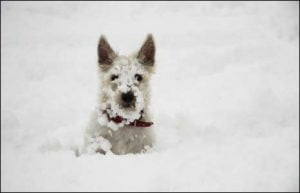
How to help your dog through the cold this Christmas
 Autumn and winter is always a challenge for humans, especially the elderly, but it can also be hard work for a dog to adjust to the sudden colder climate, and each breed of dog will have its own special needs to sustain his levels of energy.
Autumn and winter is always a challenge for humans, especially the elderly, but it can also be hard work for a dog to adjust to the sudden colder climate, and each breed of dog will have its own special needs to sustain his levels of energy.
A puppy may look to have high energy levels but cold weather can see a dramatic change, puppies are too young to be left out in the frost and snow for example.
Older, more mature, dogs that have impaired joint movement may suffer more in the winter and timing may be everything when taking them out for a daily walk.
The first step is to take your pet to the vet for a full check-up, similar to your car having a yearly MOT. It is important to make sure all vaccinations are up to date, and that flea and worming treatment routines have been established and carried out.
When the temperature starts to drop, people are advised to put on extra layers of clothing – therefore consider purchasing a coat for your pet, ideally a waterproof one that has a warm lining. Remember, if you are cold so is your dog. However, a larger dog has more chance of keeping warm than a small breed as they will have a thicker body mass, with more fat to keep warm.
If you leave your dog outside during the day he must have a warm hut or shed, with plenty of blankets, to keep him warm. In the worst weather conditions, bring your pet in overnight, dogs should be kept away from cold draughts and bedding should always be dry.
A dog that is allowed to run about in the snow will need rubbing down afterwards. Always check the bottom of his paws as trapped salt and grit can cause pain. If the hair between the pads is long, trim it to give him more comfort while out walking.
At mealtimes, make sure your pet has enough dry kibble and fresh water. Nutrition is even more important in the colder months of the year, a daily dose of fish oil will help your pet’s mobility.